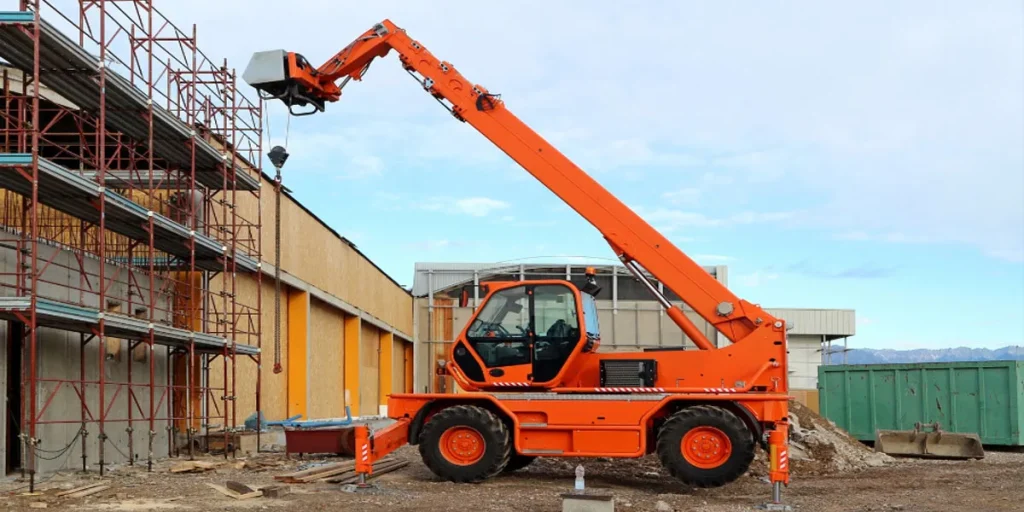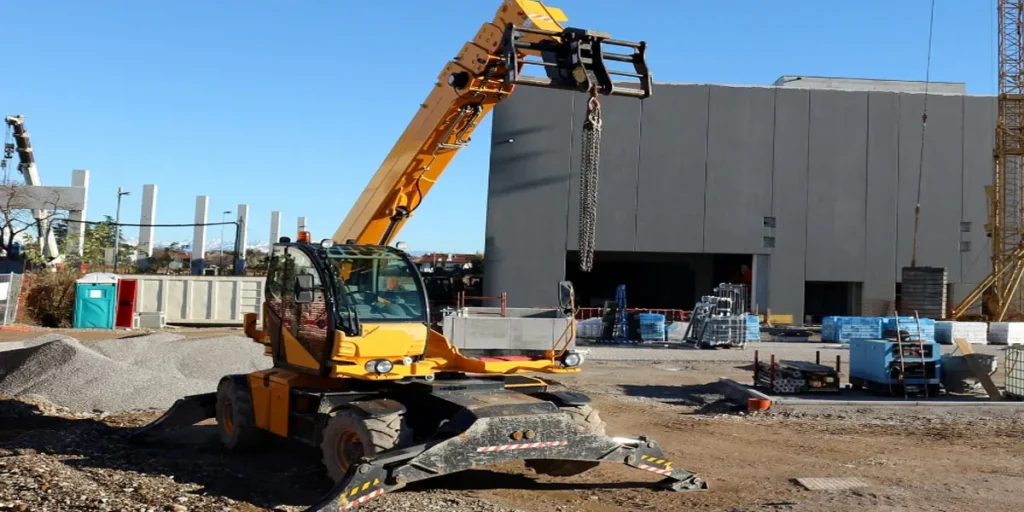A telehandler typically weighs between 10,000 and 30,000 pounds (4,536 to 13,608 kg). The exact weight depends on the model and specifications.
Telehandlers, also known as telescopic handlers or boom lifts, are versatile pieces of heavy machinery commonly used in construction and agriculture.
Their weight plays a crucial role in their stability and lifting capacity. Manufacturers design these machines to offer a balance between robustness and maneuverability, which is why there’s such a range in their weights.
These multi-purpose vehicles combine the capabilities of forklifts, cranes, and work platforms, making them essential on job sites where various tasks are performed, and different materials are handled.
Their weight contributes to their ability to lift heavy loads at various heights and reach.
Before renting or purchasing a telehandler, it’s important to consider its weight to ensure it suits the load requirements and the conditions of the work environment.
Transporting a telehandler also requires appropriate logistical planning due to its considerable weight.
Fundamentals Of Telehandlers
Telehandlers stand as versatile powerhouses in material handling. These machines lift and move materials with ease.
Their design combines features from forklifts and cranes. This makes them invaluable on construction sites and farms.
They offer both horizontal and vertical reach. Flexibility and utility define these machines.
Core Functions Of A Telehandler
Understanding a telehandler’s core functions is key to appreciating its design. At its heart, a telehandler:
- Lifts heavy loads to heights regular forklifts cannot reach.
- Moves materials where you need them over uneven terrain.
- Supports attachments like buckets, muck grabs, or winches for versatility.
Operators can extend the boom to reach beyond obstacles. The ability to navigate rough terrain allows for effective use in varied locations.
Key Components Contributing To Weight
A telehandler’s weight is essential for stability during heavy lifting. Key parts add to the total weight.
- The Chassis: Forms the base structure and is usually heavy due to safety requirements.
- The Engine: Provides the power and is significant in weight.
- Counterweights: These are crucial for balancing the loads and add much to the weight.
- The Boom: Its materials and size influence the overall heft.
Each component is designed for optimal performance and safety. The telehandler’s weight typically ranges from about 5,500 to 30,000 pounds. The exact weight depends on the model and its use.
| Lifting Capacity | Weight Range |
|---|---|
| 5,500 lbs | 10,000 – 14,000 lbs |
| 10,000 lbs | 20,000 – 26,000 lbs |
| 20,000 lbs | 30,000 – 36,000 lbs |
Weight Classes Of Telehandlers

Understanding telehandler weight classes is key for proper job planning. Telehandlers, or telescopic handlers, come in various sizes and capacities.
These classes affect how they are transported and the type of work they perform.
Compact Versus Full-size Models
Telehandlers fall into two main groups: compact and full-size. Compact models are lighter and more agile, perfect for tight spaces.
Full-size models handle heavier loads and offer longer reach.
- Compact Telehandlers: Ideal for indoor tasks and congested areas.
- Full-Size Telehandlers: Designed for construction sites and open spaces.
Average Weights Across Models
The weight of a telehandler can vary widely. Different makes and models have different weights. This data represents the spectrum.
| Model Type | Average Weight |
|---|---|
| Compact | 5500 to 11,000 lbs |
| Mid-Size | 10,000 to 20,000 lbs |
| Large | 21,000 lbs and up |
Factors such as engine size, lift capacity, and attachments influence weight. Choosing the right class is critical for meeting project needs without overburdening the site.
Factors Influencing Telehandler Weight
Understanding what makes a telehandler have its weight is crucial. A telehandler’s weight changes based on different aspects.
Let’s explore the main factors, such as materials and attachments.
Material Composition And Durability
The materials used in a telehandler affect its weight significantly. Most telehandlers comprise steel for strength. The type and amount of steel can vary, leading to different weights.
Telehandlers must be durable to handle heavy loads and tough environments. Therefore, manufacturers may use reinforced steel in critical areas.
This reinforcement adds weight but ensures longevity.
Attachments And Customization
Attachments are vital in defining a telehandler’s weight. These tools, such as buckets, forks, or winches, are added to the main structure.
Each attachment carries its own weight, and using multiple or heavy attachments increases the total weight significantly. Custom features also influence weight.
Users may request special additions that can alter the telehandler’s standard weight.
| Attachment Type | Weight Addition |
|---|---|
| Buckets | 100-600 lbs |
| Forks | 200-400 lbs |
| Winches | 300-800 lbs |
| Customizations | Varies |
- Steel type: Heavy-duty or Standard
- Reinforcements: Extra weight for durability
- Attachment variety: More means heavier
- Custom features: Unique additions add weight
Impact Of Weight On Usage

The ‘Impact of Weight on Usage’ of telehandlers is a crucial aspect to consider. These versatile machines serve a multitude of industries.
Understanding how weight influences operations assists in making informed decisions.
Operating Conditions And Terrain
Weight plays a pivotal role in how telehandlers perform under different conditions. A telehandler’s weight determines its stability and capacity on various terrains.
For example, heavier models are more stable on uneven grounds, making them suitable for construction sites or agricultural fields.
Here’s how weight impacts functionality:
- Stability: Higher weight contributes to a lower center of gravity, enhancing stability.
- Load Capacity: A stout weight rating indicates the ability to lift heavier loads.
- Terrain Adaptability: Heavier machines perform better on rugged terrain.
Operators need to select a telehandler with a weight that matches the job site conditions.
Transportation And Handling Requirements
The weight of a telehandler affects how it is transported and handled. Handling rules and transportation laws must be observed. Here are the key considerations:
- Matching the telehandler’s weight with the appropriate transport vehicle is essential.
- Special permits may be required for transporting heavier telehandlers.
- Weight affects loading and unloading time and procedures.
It is vital to understand that heavier telehandlers might demand more sophisticated transport logistics. This ensures safety and compliance with legal guidelines.
Regulatory Standards And Safety
When handling heavy machinery like telehandlers, understanding regulatory standards and safety is crucial.
These rugged machines come with a set weight and operational guidelines to ensure they are used without causing harm.
Safety isn’t a mere suggestion; it’s the bedrock of efficient and accident-free telehandler operation.
Keeping abreast of the regulations helps maintain a secure work environment. Let’s delve into the specifics.
Compliance With Industry Regulations
Telehandlers are subject to strict industry regulations for a good reason. Every model has a unique weight and capacity.
These regulations exist to prevent misuse that could lead to accidents or equipment damage.
Compliance ensures that operators use the telehandler within the recommended weight limits. Here are key points to consider:
- Check the telehandler’s user manual for maximum weight capacities.
- Understand local regulations that dictate weight limitations and operation standards.
- Ensure routine inspections and maintenance are carried out to meet compliance requirements.
Safety Protocols And Weight Considerations
Weight considerations are at the heart of telehandler safety protocols. Overloading beyond the stipulated weight can lead to tip-overs and breakdowns.
Proper training on weight distribution and the center of gravity is essential. Here’s what operators need to remember:
- Pay attention to the Load Capacity Chart for safe operation.
- Adhere to the safety checks before each use.
- If in doubt, consult experts or refer to the manufacturer’s guidelines.
Safety protocols minimize the risk of accidents and ensure that each job is done correctly and efficiently.
Training and awareness are key components in fostering a culture of safety. Always prioritize safety over speed or convenience.
Each decision has the power to protect lives and property.
FAQ About the Weight of a Telehandler
What Is The Average Weight Of A Telehandler?
Telehandlers vary widely in weight based on size and capacity.
On average, a small telehandler may weigh around 10,000 pounds, while a larger model can exceed 30,000 pounds.
Always refer to specific model specifications for precise weight details.
Are Telehandlers Heavier Than Forklifts?
Generally, telehandlers are heavier than typical forklifts due to their extended reach and larger size.
While industrial forklifts can weigh 5,000 to 10,000 pounds, telehandlers often start at around 10,000 pounds and can go much higher.
Can Telehandler Weight Impact Its Lifting Capacity?
Yes, the weight of a telehandler does impact its lifting capacity.
Heavier telehandlers generally have more counterweight, allowing them to lift heavier loads securely.
Always check the load chart for accurate capacity based on weight and reach.
How Does Telehandler Weight Affect Transportation?
The weight of a telehandler affects transportation logistics. Heavier telehandlers may require specialized transport vehicles and permits.
It’s important to consider road weight limits and transportation costs when moving telehandlers between sites.
Conclusion
Understanding telehandler weight is crucial for safety and efficiency on the job. Typical models range from 5,500 to 30,000 pounds.
Selecting the right telehandler depends on your specific lifting requirements. Remember to check the weight before renting or purchasing to ensure it meets your project needs.
Stay informed, stay safe.
Resources:
https://www.osha.gov/etools/powered-industrial-trucks/
